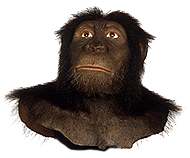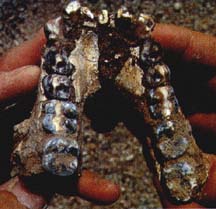Australopithecus anamensis

 This hominine species was discovered in 1994 by Maeve Leakey
in Kanapoi and Allia Bay, situated in North Kenya. It was named
Australopithecus anamensis from "anam" meaning
"lake" in the local Turkana language. The fossils (9 from
Kanapoi and 12 from Allia Bay) include upper and lower jaws,
cranial fragments, and the upper and lower parts of a leg bone
(tibia). In addition to this, the collection includes a
fragment of humerus that was found 30 years ago at the same
site at Kanapoi.
This hominine species was discovered in 1994 by Maeve Leakey
in Kanapoi and Allia Bay, situated in North Kenya. It was named
Australopithecus anamensis from "anam" meaning
"lake" in the local Turkana language. The fossils (9 from
Kanapoi and 12 from Allia Bay) include upper and lower jaws,
cranial fragments, and the upper and lower parts of a leg bone
(tibia). In addition to this, the collection includes a
fragment of humerus that was found 30 years ago at the same
site at Kanapoi.
 The Kanapoi fossils have been dated at 4.2 million years
and those at Allia Bay at 3.9 million years. The dentition
is less apelike than in
Ardipithecus ramidus, having thick enamel on
the molar teeth but relatively large canines. The tibia
implies that anamensis was larger than
ramidus and
afarensis, with an estimated weight of 46 to 55 kilograms;
its humanlike anatomy implies that anamensis
was bipedal in posture and locomotion. Although distinct
from Australopithecus afarensis, its discoveres claim that
Australopithecus anamensis
resembles the Laetoli fossils more than those found in Hadar.
The discovery of this species pushed bipedal walking back half
a million years. Facially this species resembles
afarensis a lot, it is very apelike.
The Kanapoi fossils have been dated at 4.2 million years
and those at Allia Bay at 3.9 million years. The dentition
is less apelike than in
Ardipithecus ramidus, having thick enamel on
the molar teeth but relatively large canines. The tibia
implies that anamensis was larger than
ramidus and
afarensis, with an estimated weight of 46 to 55 kilograms;
its humanlike anatomy implies that anamensis
was bipedal in posture and locomotion. Although distinct
from Australopithecus afarensis, its discoveres claim that
Australopithecus anamensis
resembles the Laetoli fossils more than those found in Hadar.
The discovery of this species pushed bipedal walking back half
a million years. Facially this species resembles
afarensis a lot, it is very apelike.
It was found along the East African Rift valley and due to the
dating of this hominine species, Australopithecus anamensis
could possibly be an ancestor to "Lucy" and counterparts.
Reference: Leakey, MG, et al. New four-million-year-old hominid species from Kanapoi and Allia Bay, Kenya. Nature 1995; 376: p. 565-571.
|
Ardipithecus ramidus
|
Australopithecus anamensis
|
Australopithecus afarensis
|
|
Australopithecus africanus
|
Australopithecus aethiopicus
|
Australopithecus boisei
|
|
Australopithecus robustus
|
Homo habilis
|
Homo rudolfensis
|
Homo erectus
|
Homo ergaster
|
|
Homo heidelbergensis
|
Homo neanderthalensis
|
Homo sapiens
|
 This hominine species was discovered in 1994 by Maeve Leakey
in Kanapoi and Allia Bay, situated in North Kenya. It was named
Australopithecus anamensis from "anam" meaning
"lake" in the local Turkana language. The fossils (9 from
Kanapoi and 12 from Allia Bay) include upper and lower jaws,
cranial fragments, and the upper and lower parts of a leg bone
(tibia). In addition to this, the collection includes a
fragment of humerus that was found 30 years ago at the same
site at Kanapoi.
This hominine species was discovered in 1994 by Maeve Leakey
in Kanapoi and Allia Bay, situated in North Kenya. It was named
Australopithecus anamensis from "anam" meaning
"lake" in the local Turkana language. The fossils (9 from
Kanapoi and 12 from Allia Bay) include upper and lower jaws,
cranial fragments, and the upper and lower parts of a leg bone
(tibia). In addition to this, the collection includes a
fragment of humerus that was found 30 years ago at the same
site at Kanapoi.
 The Kanapoi fossils have been dated at 4.2 million years
and those at Allia Bay at 3.9 million years. The dentition
is less apelike than in
The Kanapoi fossils have been dated at 4.2 million years
and those at Allia Bay at 3.9 million years. The dentition
is less apelike than in